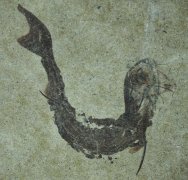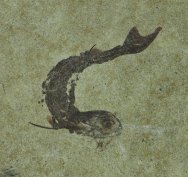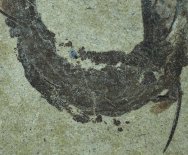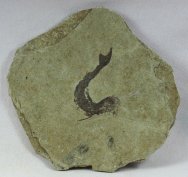Carycinacanthus
lopatinius = Homalacanthus lopatinius
Class Acanthodii,
Order Acanthodiformes, Family Cheiracanthidae
Geological
Time: Lower Carboniferous, Tournassian Stage (~350 million years
ago)
Size (25.4
mm = 1 inch): Fish fossil is 55 mm (along backbone) on a 90 mm by 90
mm matrix
Fossil Site:
Krasnoyarsk Region, Russia
Fossil Code:
GF121
Price: Sold
|  Description:
The Acanthodians are jaw-bearing fish who still are the subject
of dispute over their systematic position. They possess highly-advanced,
spindle-shaped bodies thought to have made them swift swimmers.
The body was covered in small mosaic-like scales which are readily
visible in this specimen. They possessed small teeth which were
typically confined to the lower jaw; some were toothless. The
feature they all share in common is the fact that all fins other
than the caudal are supported by massive spines formed of dentine.
Indeed, the name Acanthodii is derived from the Greek word for
spine. The oldest acanthodian lived during the late Ordovician.
They reached their peak during the Devonian, and became extinct
during the Great Dying of the end-Permian extinction. This well-preserved
example is known as Carycinacanthus, although some prefer to
use the patronymic genus Acanthodes. As is typical, the most
prominent feature to be seen here are the diagnostic spines. Description:
The Acanthodians are jaw-bearing fish who still are the subject
of dispute over their systematic position. They possess highly-advanced,
spindle-shaped bodies thought to have made them swift swimmers.
The body was covered in small mosaic-like scales which are readily
visible in this specimen. They possessed small teeth which were
typically confined to the lower jaw; some were toothless. The
feature they all share in common is the fact that all fins other
than the caudal are supported by massive spines formed of dentine.
Indeed, the name Acanthodii is derived from the Greek word for
spine. The oldest acanthodian lived during the late Ordovician.
They reached their peak during the Devonian, and became extinct
during the Great Dying of the end-Permian extinction. This well-preserved
example is known as Carycinacanthus, although some prefer to
use the patronymic genus Acanthodes. As is typical, the most
prominent feature to be seen here are the diagnostic spines.
|
|



